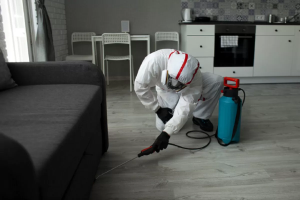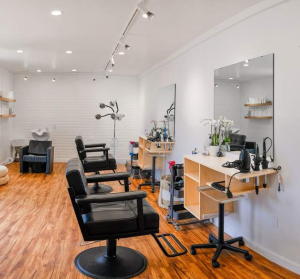Pest Control is the practice of managing pests to protect people, property and the environment. This can be accomplished through prevention, suppression or eradication. Effective Pest Management requires a combination of tactics that cause the least harm to humans, property and the environment.
Mechanical and physical controls use barriers, nets and traps to prevent pest entry. Biological, chemical and cultural controls alter environmental factors that support pest populations. Contact Pest Control Bridgewater NJ now!

Pests can damage property and crops, contaminate food supplies, cause health problems and pose other risks to people and animals. Proper pest control management can prevent such problems and help maintain a secure environment for communities, homes and businesses.
The most effective and cost-efficient approach to pest control is prevention. Regular inspections and treatments can help spot problems early, when they are easier to deal with. Structural preventive measures such as sealing cracks and gaps can stop pests from entering buildings or rooms. Keeping garbage bins tightly closed and regularly emptied prevents pests from gaining access to food sources. Regular gardening maintenance, including trimming trees and bushes, prevents pests from gaining access to building foundations or hiding places in the yard.
Proper storage and handling of materials in factories, warehouses and retail environments can also prevent pest infestations. Different classes of goods should be stored separately where possible, and old stock should be rotated to avoid contamination or pest build-up. Wooden and metal pallets should be inspected carefully for signs of damage or insect activity. Food packaging and raw ingredients should be stored away from finished products to minimise the risk of cross-infestation.
Effective biological control involves releasing natural enemies of the pest to help reduce its population. This can be supplemented with chemical controls, such as pheromones and juvenile hormones. Biological methods are generally less hazardous than chemicals, but they may take longer to produce results and can be costly.
Educating employees and clients on the importance of pest prevention can empower them to make more informed choices that help to keep their environments free from pests. Training on the habits, lifestyle and preferred habitat of common pests can also improve preventive practices.
When using pesticides, it is important to read and follow the instructions on the label to ensure that they are used correctly and safely. It is also important to consider the environmental impact of any products being used and the potential hazards they may pose to children, pets and the surrounding community. For example, surface sprays should be avoided near areas where people often touch, such as kitchen benches. If applying surface sprays, they should be sprayed in out-of-the-way locations such as along skirting boards or under floors.
Suppression
The goal of suppression is to reduce pest numbers or damage to an acceptable level. Some pest control strategies use natural enemies of the pest (predators, parasites, herbivores, or pathogens) to control it; this is called biological control. It typically involves releasing large numbers of the natural enemy into the environment, often in conjunction with other management techniques.
Other control tactics rely on changing the environment to make it less suitable for pests, such as trapping and habitat modification. Many of these methods are useful only for specific types of pests and may not be appropriate for all locations.
Weather conditions, especially temperature and day length, affect pest populations by affecting their growth rates and ability to reproduce. Climate can also indirectly affect pests by altering the availability of food or shelter. For example, cold temperatures or drought can reduce the supply of plant-eating pests by limiting their ability to find host plants.
Clutter provides places for pests to breed and hide, so clean up your space. Eliminate clutter, such as stacks of books or papers, and caulk cracks and crevices.
Some pests are controlled by natural enemies in their natural environment, including predatory or parasitic insects and birds, fish, amphibians, mammals, and nematodes. The chemical compounds produced by some of these organisms, such as pheromones and juvenile hormones, can suppress pest populations.
Other controls are mechanical, physical, or chemical and include traps, barriers, screens, fencing, nets, radiation, and electricity. Some of these controls may be effective only for a particular type of pest, so they should always be used in combination with other control methods.
Some pest control substances are sprayed or swabbed onto surfaces to kill them or block their growth. These are known as acaricides or insecticides. They can be very dangerous to humans, pets, and livestock if not used correctly or at the right time, so it is important to read and follow the label directions.
Other chemicals can be used to control pests in enclosed environments, such as fungicides and bactericides. These substances are generally safer to use than pesticides, but they should be used with caution. Consult your local cooperative extension service office for recommendations for your area.
Treatment
Pest control involves a combination of preventive methods that deter pests (such as exclusion, repulsion and physical removal) in conjunction with treatments to kill existing infestations. Treatments can include sprays, baits, gels and traps. In general, the use of pesticides is a last resort to eliminate the infestation, and only after other non-toxic methods have been exhausted. It is important that any pesticides used are safe for people, pets and the environment.
Pests can cause many problems, including damage to property and health risks. Some pests, such as cockroaches, ants and rodents carry bacteria that can make humans sick. Others, such as venomous insects, can cause painful bites or severe allergic reactions. In addition, pests can spread germs and spoil food, which can threaten the safety of people and animals.
The best way to reduce a pest problem is by preventing it in the first place. Regular scouting and monitoring can help to identify potential problems before they become too serious. This includes looking for signs of pests, such as droppings, gnawed materials and damage to property. It also means paying attention to the conditions around your property, and making any necessary changes to avoid attracting pests.
If you do have a pest problem, it’s important to take prompt action. The longer you wait, the harder it will be to eradicate the problem and keep it at bay. It’s also worth remembering that there may not be a single solution to your pest problem, and you may need to try a few different approaches before you see results.
While over-the-counter products, such as baits, traps and sprays, are often effective against specific pests, they are generally only a short-term solution. For long-term relief, you should consider professional treatment options.
It’s also essential to carefully follow product instructions to ensure you get the best results. For example, it’s important to remove food and cooking utensils before applying surface sprays, and to cover or seal waste bins before a pesticide is applied. It’s also a good idea to store any pesticides out of reach of children and pets.
Monitoring
Inspecting and monitoring pest populations is the heart of any IPM program. Monitoring provides the data necessary to determine whether or not control is needed and when to apply a control measure. It helps managers to make decisions based on established facts and avoid making uninformed assumptions about the presence or absence of pests. Such uninformed assumptions can lead to the application of unnecessary chemicals and waste of resources.
Insects, rodents, fungi and weeds are all common pests in schools and can affect the health and safety of students, staff and visitors. Monitoring allows for the detection and prevention of these pests before they become a serious problem and also helps to identify their impact on a facility.
Many pests are active during times when people are not looking for them and can build up to high population levels before they are noticed. This is particularly true for weeds that grow under slabs and walls or in wall voids, or pests that hide underground or in crevices. Monitoring using insect light traps, pheromone traps and glue boards can provide early detection.
The most important piece of information from monitoring is correct identification of the pest. Identifying the pest allows for a better understanding of its biology and life cycle, including what it needs to survive and thrive. It also helps to develop a strategy for its control.
In addition to insect identification, the number of pests trapped on a monitor can provide valuable information about the severity of the infestation. If there are no pests on a trap for a given period of time, it may indicate that a problem is under control and that the action threshold has been reached. If traps are regularly full, the level of pests present may be too high to control them using non-chemical means.
Other important information can be gained by observing the behavior of pests. For example, if all the bait in a trap is eaten, it may be necessary to increase the frequency of trap checks and to use a more effective type of trap.








